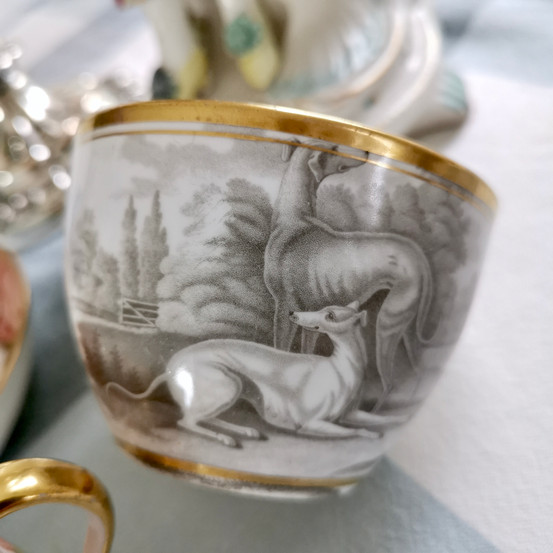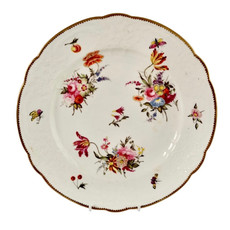Search
Bat, pluck and dust
- willa

- May 8, 2021
- 3 min read
It's a dark rainy spring morning here, and when picking a little cup for my morning coffee I was enamoured by the variously printed Spode cups from the first two decades of the 19th Century. Here, you see my favourite little coffee can with whippets ready to start the day, surrounded by two other sets. They are incredibly finely printed and today I will explain a bit about how these treasures were made.
Bat printing
The beautiful whippets and the set with the cute rabbits in the picture above were "bat printed". While we all know the ubiquitous transfer-printed Spode blue and white tableware, bat printed images are more rare. You can see that although these monochrome images were printed, they are very fine and emotionally touching images. This is typical of bat printing; it was often used for images of animals or mothers and children, that were meant to evoke an emotional connection.
Bat printing was generally only done between about 1810 and 1820. It has nothing to do with bats (the animals); it was a form of transfer printing by which an etched picture was transferred not by a sheet of paper, but by a slab of gelatine called a “bat”, which would transfer sticky linseed oil onto the porcelain object. This was then covered in powdered paint. The paint would stick to the oil print of the original etching and that’s how the picture emerged. Pressing the bat onto the porcelain was often done with the palm of the hand, so bat printed images are usually no bigger than the surface that one hand can cover. If in doubt, try laying your hand over the image, and see if it fits!
Another difference with transfer printing is that the etching itself was not scratched into the copper plate, but stippled; this created soft, evocative tones. Even though the decorations come out in monochrome, they tend to have more subtlety and emotional expression than transfer prints or even hand painted decorations. Bat printing was very time consuming and messy so it was not done on a large scale and didn't survive long beyond the early 19th Century.
Pluck and dust printing
There was a third method of printing: pluck and dust. This technique was used in about the same time period and it was in fact a hybrid between transfer printing and bat printing. First, the copper plate used for printing was heated and covered in oil. The gelatine bat was pressed onto the plate, but then, rather than being pressed onto the piece of porcelain directly, it was pressed onto a piece of paper. This piece of paper was then used to transfer the image onto the porcelain. Using paper made it possible to cover much larger areas and you can see how the beautiful red rose border would have been transferred by a long piece of paper that could be used in stages to cover as long a rim as you wanted.
Both bat printing and pluck and dust printing went out of fashion in the 1820s; presumably it was just too difficult to do when factories were under enormous pressure to mass produce porcelain for a growing middle class. You don't come across porcelain that was printed with either technique very often, but when you do, you always feel the power of the evocative images used. Personally, I love the black and white Spode items with animals and I can never resist them for my personal collection when I come across them!
Where to find things
My whippets and rabbits are not for sale, but I have several bat printed and pluck and dust printed items available... you can find them here in my shop. And soon you will see a stunning large bat printed coffee service by New Hall... If you always want to see the latest additions, follow me on Instagram... I post pictures and a story every single day.
Free Copy of Homes & Antiques
Last week I wrote about my interview and new column in Homes & Antiques... order your free copy here! It will have an interview with myself alongside 5 other collectors. And if you want to follow my monthly column where I speak about the history of British porcelain, you can take out a subscription.
Wish List ❤️
Don't forget, you can now create your own profile on the site and keep a wish list. Click on the Log In icon at the top right of each page.
Happy weekend, and keep those whippets away from the rabbits! 🐕🐇🐕🐇
This week's new treasures:









































































Comments